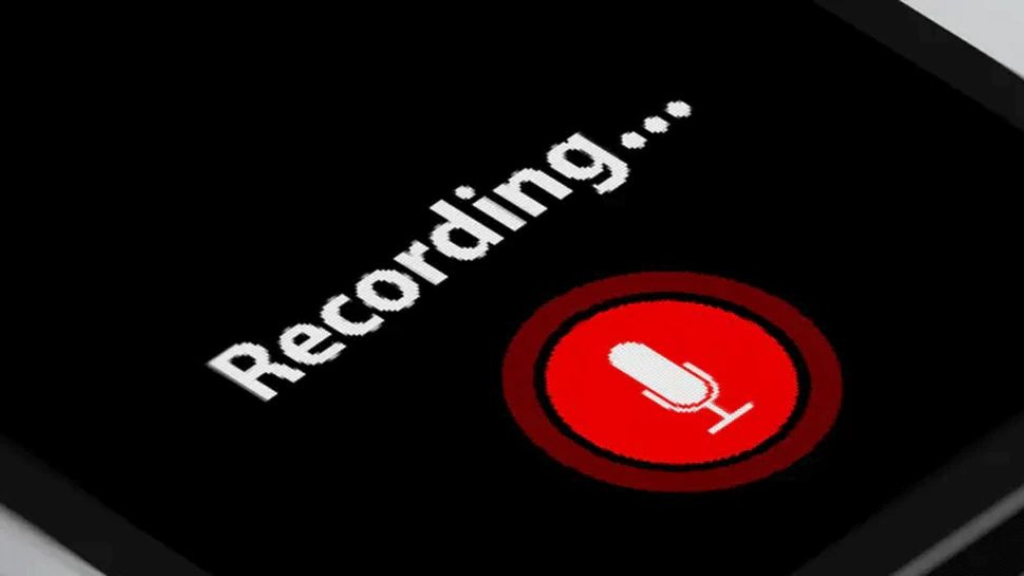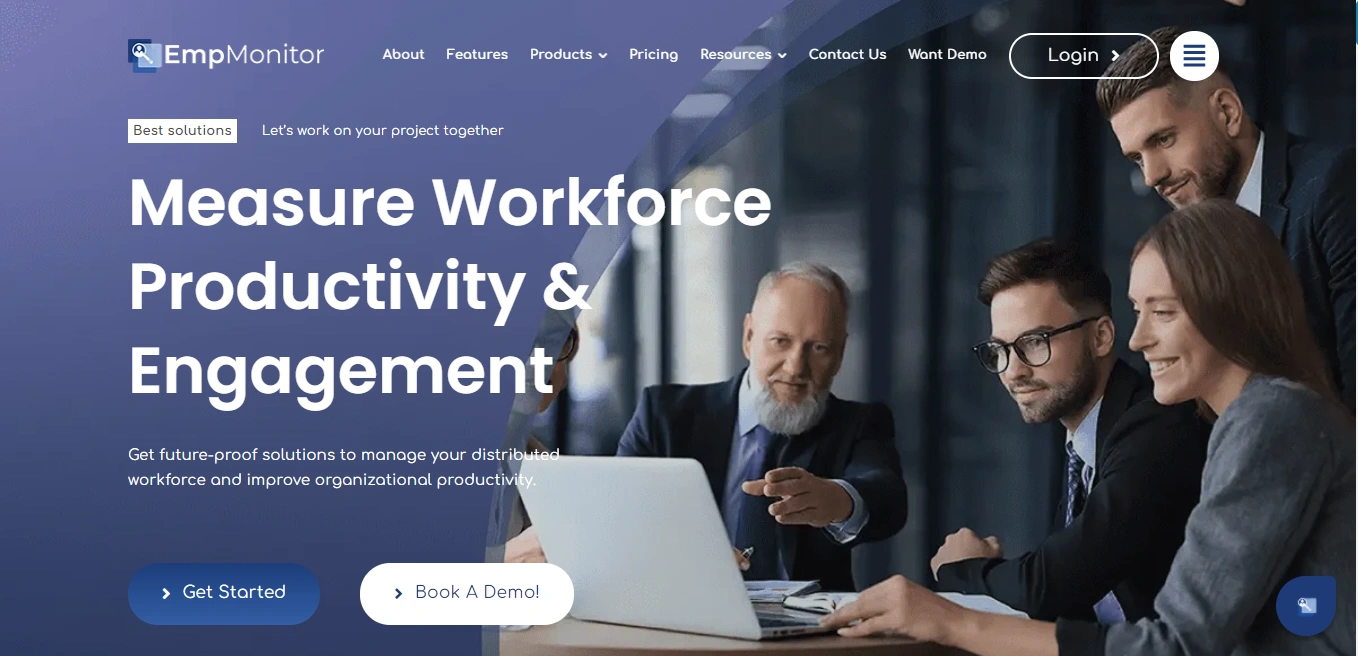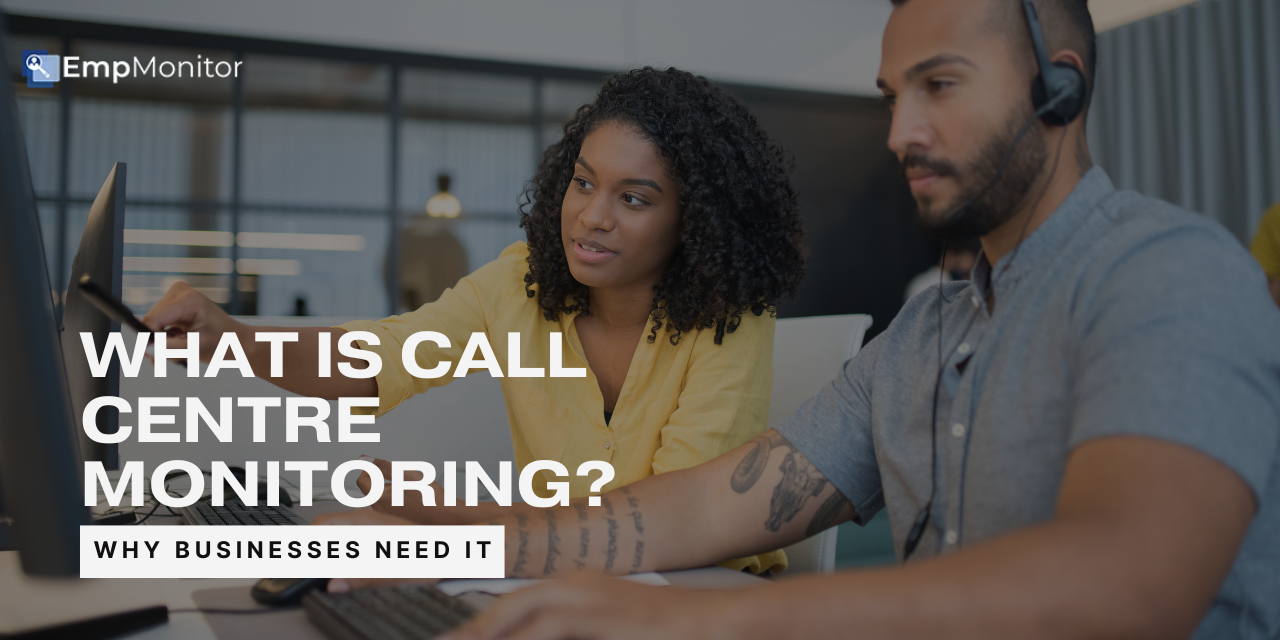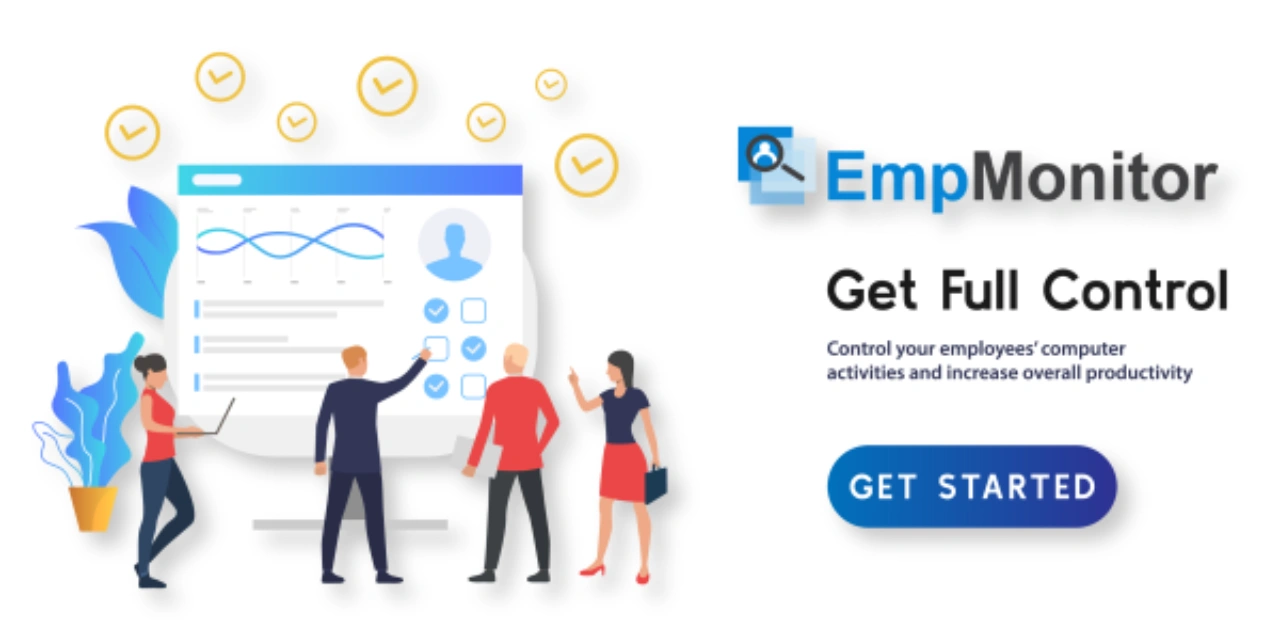Every day, call centers handle thousands of customer interactions—some exceptional, some average, and some that drive customers away. The problem? Most businesses only review a tiny fraction of these calls. Without proper call center monitoring, companies miss critical insights that could improve customer satisfaction, agent performance, and overall efficiency.
A study by Harvard Business Review found that 42% of service agents fail to resolve customer issues on the first call, leading to frustration and lost revenue. The solution isn’t just listening to more calls—it’s about monitoring them strategically.
This guide will cover what call centre monitoring really means, how it works, and the different monitoring methods that deliver results.
By the end, you’ll understand exactly how monitoring can turn your call center from a cost center into a revenue driver.
Hit ‘Play’ Button & Tune Into The Blog!
What Is Call Center Monitoring?
Call center monitoring refers to the systematic process of tracking, analyzing, and evaluating customer service interactions within a call center. Businesses use call center call monitoring to assess agent performance, ensure compliance, and improve customer service quality.
By leveraging monitoring tools, businesses can:
- Track real-time and recorded customer interactions.
- Evaluate essential Key Performance Indicators (KPIs), including response time, resolution rate, and customer satisfaction scores.
- Identify areas of improvement for agents through feedback and training.
Call center monitoring is not limited to supervisors listening to calls—Think of it like a coach reviewing game footage. By analyzing real conversations, businesses can spot what’s working and what needs improvement.
Why Monitoring Matters Now More Than Ever?
Customer expectations have never been higher. According to PwC, 1 in 3 customers will leave a brand they love after just one bad experience. In this environment, call centers can’t afford to operate blindly.
Here’s why monitoring is crucial:
1. Elevating Customer Experiences
Identify pain points, service inconsistencies, and personalization opportunities for better interactions.
2. Developing Agent Skills
Analyze calls to coach effectively, recognize top talent, and fix knowledge gaps quickly.
3. Ensuring Business Compliance
Prevent regulatory breaches, data security risks, and brand reputation issues.
4. Driving Operational Efficiency
Optimize staffing, reduce handle times, and improve first-call resolution rates.
(Wondering how this works in practice? Let’s examine the different monitoring methods.)
Key Methods for Effective Call Center Monitoring
To manage call centers effectively, businesses use various strategies to track agent performance, enhance customer experience, and maintain compliance. Here are the most effective call centre monitoring techniques:
1. Real-Time Call Monitoring
Live call monitoring enables managers to assess ongoing customer interactions without disrupting conversations. It ensures that agents follow scripts, maintain quality service, and resolve issues efficiently.
This method includes four key techniques:
Call Listening – Silent Supervision for Quality Control
With call listening, supervisors can tune into live calls without notifying the agent or customer. This helps in evaluating service quality, compliance, and agent efficiency.
How It Works:
- Managers select an ongoing call via the call center call monitoring system.
- They listen without interacting.
- Feedback is shared post-call to improve performance.
Call Whispering – Instant Agent Guidance
Call whispering allows managers to communicate with agents in real time, without the customer hearing. It’s useful for coaching agents during complex conversations.
How It Works:
- The supervisor enables the whisper mode on an active call.
- The agent hears instructions while continuing the conversation with the customer.
- This helps resolve issues smoothly without external intervention.
Call Barging – Supervisor Takeover When Needed
When critical intervention is required, supervisors use call barging to join the conversation directly. Both the agent and the customer can listen to them.
How It Works:
- The manager monitors an ongoing call.
- If necessary, they step in and address the issue.
- They either assist or take over the call entirely.
Call Intercept – Redirecting Critical Calls
With call intercept, supervisors can reroute or take over a call before it reaches an agent. This is helpful for handling VIP clients, escalated complaints, or sensitive issues.
How It Works:
- Calls flagged under specific criteria (e.g., VIP customer, fraud concerns) are redirected.
- If an agent struggles mid-call, the supervisor can take over immediately.
2. Call Recording & Playback – Data-Driven Performance Analysis

There are three primary types of call center monitoring through recording:
Full Call Recording – Capture Everything
Every inbound and outbound call is automatically recorded and stored for later review.
How It Works:
- All calls are logged and tagged in the system.
- Managers can search recordings by agent, date, or keywords.
- Performance reviews and compliance audits use these recordings.
Also Read: –
The Ultimate Guide To Call Center Workforce Management
How To Choose The Best Employee Screen Monitoring Software: Challenges and Best Practices
Selective Call Recording – Focus on Key Conversations
Only specific calls—such as VIP interactions, disputes, or compliance-related calls—are recorded.
How It Works:
- Calls are filtered based on predefined rules (e.g., flagged complaints, fraud cases).
- Agents handling critical tasks may have their calls recorded automatically.
On-Demand Call Recording – Manual Recording for Key Moments
Supervisors or agents can manually start and stop recordings for specific calls.
How It Works:
- Agents press a record button during a call.
- Some systems trigger recording when specific words (e.g., “escalation” or “legal”) are detected.
3. AI-Powered Speech & Sentiment Analysis
Businesses now leverage AI-driven tools to analyze conversations for customer sentiment, keyword trends, and compliance risks.
Keyword & Phrase Recognition – Tracking Critical Topics
AI scans call transcripts to detect specific words or phrases relevant to business operations.
How It Works:
- Speech is converted to text via AI.
- The system flags key phrases (e.g., “cancel subscription” or “speak to a supervisor”).
- Alerts are triggered when necessary for further review.
Emotion Detection – Understanding Customer Sentiment
AI identifies emotions based on tone, pitch, and speech patterns to detect frustration, satisfaction, or confusion.
How It Works:
- Calls are monitored in real-time for emotional cues.
- The system allocates a sentiment score, categorizing it as positive, neutral, or negative.
- Alerts notify managers when customers express extreme dissatisfaction.
Silence & Interruption Tracking – Evaluating Call Dynamics
Analyzing pauses and interruptions helps improve agent responsiveness and identify gaps in communication.
How It Works:
- AI detects long silences (which may indicate agent hesitation).
- Excessive interruptions are flagged.
- Supervisors receive insights on agent responsiveness and communication style.
Different Tools Used for Call Center Monitoring
1. Call Recording Software
Call recording software is essential for call centre monitoring, capturing and storing customer interactions for quality assurance, compliance, and training.
Key Features:
- Full & Selective Call Recording – Businesses can monitor call center conversations entirely or based on predefined criteria.
- Speech Transcription – Transforms recorded calls into searchable text for easy reference.
- Sentiment Analysis – Employs AI to identify customer satisfaction or frustration levels.
- Compliance Management – Ensures GDPR, PCI DSS, and HIPAA compliance with encrypted storage.
- Keyword Tracking – Helps identify recurring issues by scanning conversations for specific words.
2. Screen Monitoring & Recording Tools
These tools track agent activity in real time, helping businesses enhance efficiency and ensure compliance.
Key Features:
- Live Screen Monitoring – Enables supervisors to view agent desktops in real time.
- Screen Recording – Captures sessions for audit and training purposes.
- Application Usage Tracking – Ensures agents use only approved platforms.
- Data Loss Prevention (DLP) Alerts – Flags unauthorized actions that might risk customer data security.
3. Workforce Productivity Monitoring Software
Beyond call monitoring, maintaining agent productivity is crucial for sustaining efficiency in a call center. Workforce productivity monitoring tools help track work patterns, reduce idle time, and improve adherence to schedules.
Many businesses use employee management software like EmpMonitor, offering real-time insights into agent productivity, shift adherence, and workflow efficiency. By leveraging such solutions, managers can make data-driven decisions to enhance performance without micromanaging.
How EmpMonitor Enhances Call Center Monitoring?

- Screen Monitoring – Gain live insights into agent activity without disrupting workflows.
- Productivity Tracker – Analyze work patterns, identify bottlenecks, and improve efficiency.
- Compliance & Data Security – Automates monitoring to ensure adherence to industry regulations.
- Reports & Insights – Get detailed analytics on agent performance to make data-driven decisions.
- Real-Time Alerts – Receive instant notifications for unusual activities or potential policy violations.
- User Behavior Analytics – Understand behavioral trends with detailed logs of app usage, idle time, and active hours.
By integrating a time tracking software like EmpMonitor into call center operations, businesses can enhance efficiency, maintain quality service, and ensure compliance—all while fostering a productive work environment.
What Does Quality Assurance (QA) Mean in a Call Center?
Quality Assurance (QA) in call center monitoring ensures service consistency, regulatory compliance, and continuous agent performance enhancement. It helps businesses:
- Maintain call quality standards for customer interactions.
- Ensure agents follow company policies and scripts.
- Identify performance gaps for targeted training.
How Does Call Center Monitoring Enhance QA?
Call center monitoring strengthens quality assurance by standardizing service, identifying improvement areas, and ensuring compliance for exceptional customer experiences.
1. Standardized Service Delivery
Tracking ensures that each customer consistently receives high-quality service by monitoring:
- Agent greetings, authentication steps, and issue resolution.
- Response accuracy and customer satisfaction levels.
2. Identifying Training Gaps
Call monitoring highlights skill gaps and areas for improvement:
- Identify underperforming agents through call pattern analysis and sentiment evaluation.
- Provide personalized coaching to boost productivity.
3. Ensuring Compliance
Call centers handle sensitive data, making regulatory adherence crucial:
- Ensure agents follow PCI DSS, GDPR, and HIPAA guidelines.
- Utilize screen monitoring and data loss prevention tools to detect policy violations.
4. Enhancing Customer Experience
Call monitoring helps improve CX and satisfaction by:
- Reducing wait times through workflow optimization.
- Leveraging AI speech analytics to identify frustration instantly.
Challenges in Call Center Monitoring & Solutions
Addressing call center monitoring challenges with smart, scalable solutions ensures operational efficiency and compliance in both in-office and remote setups.
1. Agent Resistance
Solution: Create a transparent monitoring process where agents understand what is tracked and why.Foster a culture of trust by involving them in setting fair performance standards.
2. Data Overload
Solution: Prioritize 3-5 essential metrics rather than tracking everything. Use automated alerts to highlight major deviations. This helps streamline decision-making and prevents teams from drowning in unnecessary data.
3. Inconsistent Quality Assessments
Solution: Establish uniform evaluations using clear scoring guidelines and benchmark calls for precision. Train QA teams regularly to maintain objectivity and ensure consistent evaluations.
4. Outdated Technology
Solution: Utilize AI-powered monitoring for real-time and efficient call analysis. Modern tools enhance accuracy, reduce manual work, and scale easily with growing operations.
5. Privacy & Compliance Issues
Solution: Use automated compliance tools to redact sensitive data and ensure legal adherence. Regular audits and access controls further protect sensitive information from breaches.
6. Remote Workforce Monitoring
Solution: Adopt cloud-based monitoring with secure VPN access to maintain data security and performance tracking. Ensure agents remain accountable while preserving flexibility in remote work environments.
Best Practices for Call Center Monitoring
Implementing strategic monitoring practices ensures improved performance, compliance, and a healthier work culture for call center teams.
1. Set Clear Objectives
Focus on key KPIs like FCR for churn reduction or QA scores for compliance. Avoid tracking excessive, irrelevant data. Clear goals help teams stay aligned and ensure monitoring drives actionable improvements.
2. Balance Monitoring Methods
Use real-time monitoring for urgent cases and post-call analysis for long-term improvement. A mix ensures effective oversight. This approach provides both immediate resolution and deeper insight into recurring trends.
3. Automate for Efficiency
AI tools can analyze calls, detect compliance risks, and provide instant alerts. This reduces manual workload and speeds up insights. Automation ensures consistency, accuracy, and scalability across large volumes of data.
4. Support Agent Well-Being
Encourage self-reviews, recognize high performers, and avoid micromanagement. A positive environment boosts retention and performance. When agents feel valued and trusted, they are more likely to stay engaged and motivated.
Smart monitoring leads to better service, compliance, and agent satisfaction!
Transforming Call Centers with Smart Monitoring
Call center monitoring isn’t just about tracking calls—it’s about enhancing customer experience while ensuring agents perform at their best. With customer expectations at an all-time high, businesses that implement strategic monitoring can improve satisfaction, compliance, and operational efficiency.
By leveraging real-time monitoring, AI-driven insights, and workforce productivity tools like EmpMonitor, businesses can turn their call centers into revenue-generating assets. The key lies in using the right mix of monitoring techniques to enhance performance, streamline operations, and maintain compliance.
In the end, smart monitoring isn’t about control—it’s about empowerment. When done right, it leads to happier customers, more productive agents, and a stronger bottom line.
FAQs: –
1. What is the purpose of call center monitoring?
Call center monitoring helps businesses track agent performance, improve customer service, ensure compliance, and enhance operational efficiency. It provides insights into service quality and helps optimize workflows.
2. What is the 80/20 rule in a call center?
The 80/20 rule means that 80% of incoming calls should be answered within 20 seconds. It’s a common industry benchmark used to measure responsiveness and customer service efficiency.
3. How can call center monitoring improve customer satisfaction?
By analyzing calls, tracking performance metrics, and providing targeted coaching, businesses can reduce wait times, enhance agent efficiency, and deliver a more personalized and seamless customer experience.












